Santorini, the famous Greek island rich in history and spectacular landscapes, is home to the charming village of Akrotiri. This place provides an ideal getaway for a day on the island, where you can enjoy one of Santorini’s most picturesque beaches and explore the remnants of the ancient city.
A historic village that thrived on the island before the volcanic eruption that shaped today’s landscape. If you are visiting Santorini and wish to explore the area, keep this Akrotiri guide handy to know what to do and see. The ultimate guide you need for your excursion to Akrotiri!
- Where is Akrotiri located?
- When to Visit Akrotiri – Different Seasons
- Akrotiri Archaeological Site Opening Hours
- The Archaeological Site of Akrotiri
- The Village of Akrotiri Today
- The Akrotiri Lighthouse
- The Fabulous Beaches Around Akrotiri
- Stay in Akrotiri
- Where to Eat in Akrotiri, Santorini?
- The Edge Restaurant
- The map of Akrotiri in Santorini
Where is Akrotiri located?
Akrotiri is situated on the southwest coast of the island of Santorini, overlooking the Aegean Sea. The village is surrounded by breathtaking landscapes and is only 15 kilometers south of Fira, the island’s capital.
Perched on the slopes of a hill, it offers stunning views of the sea and the caldera. This unique location allows Akrotiri to be both close to the bustling city of the island yet far enough to provide a peaceful ambiance and an idyllic setting.
Its proximity to the sea allows for beautiful beaches nearby and magnificent ocean sunsets. I find Akrotiri’s location perfect for those seeking to combine historical exploration and seaside relaxation.
When to Visit Akrotiri – Different Seasons
Akrotiri, on the island of Santorini in Greece, is a must-visit destination throughout the year. But when is the best time to plan your visit? It depends on your interests. Here’s a more detailed analysis of each season to help you make the best choice:
Spring in Akrotiri:
Spring is an ideal time to visit Akrotiri. The temperatures are pleasant, and wildflowers are in bloom, adding to the island’s beauty. Furthermore, the crowds are minimal, allowing you to explore the archaeological site and museums in peace without feeling overwhelmed.
Summer in Akrotiri:
Summer is the perfect time to enjoy the beaches of Akrotiri. White Beach is accessible by boat, and the weather is guaranteed for a day of swimming and relaxation. Moreover, the archaeological site and museums remain open late into the evening, giving you more time to explore.
Autumn in Akrotiri:
Autumn is a great season to visit Akrotiri if you want to avoid crowds. Temperatures remain pleasant, and the colors of nature change. The archaeological site and museums stay open, giving you the opportunity to explore these ancient relics at your own pace.
Winter in Akrotiri:
Winter in Akrotiri can be a bit cooler, but it aligns with the tranquil ambiance of the island during this season. The archaeological site and museums remain open, and there are fewer tourists, allowing you to explore these historical remnants in peace.
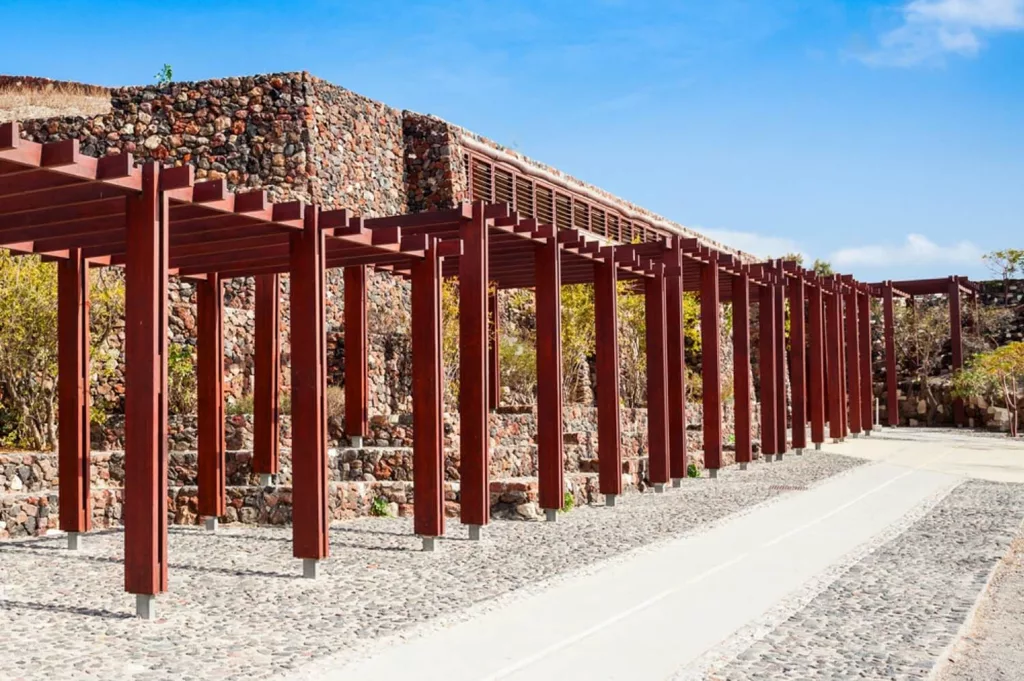
Akrotiri Archaeological Site Opening Hours
Winter Hours:
November to March
- Wednesday to Monday : 8h30 to 15h30
- Closed on Tuesday
Summer Hours:
April to October
- Thursday to Monday: 8h30 to 20h00
- Wednesday : 8h30 to 15h30
- Closed on Tuesday
Free days:
- March 6th
- April 18th
- May 18th
- Last weekend of September
- October 28th
- First sunday of the month, from November to March
The Archaeological Site of Akrotiri
The ruins of Akrotiri house one of the oldest and most significant archaeological sites from the Bronze Age in Europe. Protected by a thick layer of volcanic ash for centuries, this has preserved the site and numerous ancient objects in pristine condition. This allowed archaeologists to make unique discoveries and learn much about the lifestyle and economy of this flourishing prehistoric site.
The History of the Ancient Village of Akrotiri
The ancient city of Akrotiri was a significant settlement in the Aegean, with its earliest inhabitants dating back to the late Neolithic era in the 4th millennium BC. Archaeological findings easily connect the city of Akrotiri to the Minoan civilization that thrived on the island of Crete.
Akrotiri enjoyed a central position in the Aegean Sea, leading to an increase in its geopolitical power. It didn’t take long for the coastal city to become a major port maintaining trade routes with other islands, including Crete and Cyprus, as well as more distant cultures such as the Egyptians and various civilizations that ruled in present-day Syria.
A Very Important Economic Center
Over the years and with the growth of its economic power, the site became a hub of Aegean Sea trade with its significant port. Trade included gold, silver, locally produced saffron, ceramics, and tin, an essential metal that, when alloyed with copper (likely sourced from Cyprus), was used to produce bronze.
The Akrotiri Minoans evolved into a remarkable urban center and developed an impressive fleet for trade. Similar to Heraklion (Knossos) in Crete, the Minoan society lived in coastal cities, often unprotected and without defensive walls.
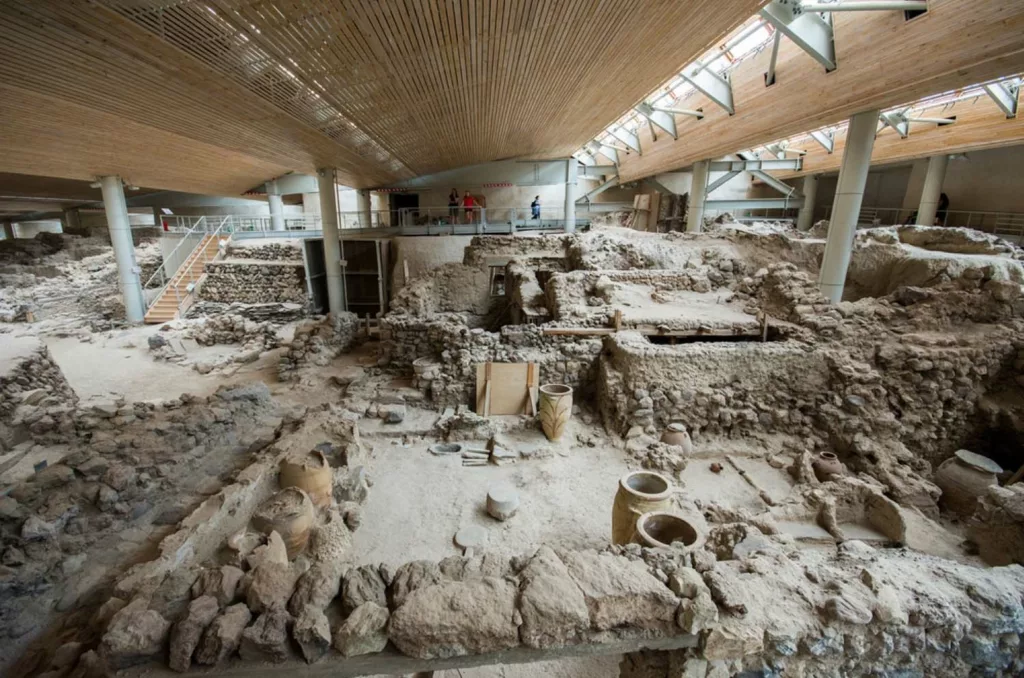
The Enigmatic Destruction of Akrotiri
The tragic fate of Akrotiri was similar to that of Pompeii in Italy, which perished under the ashes of Mount Vesuvius. Around 1600 BC, the entire city was buried under a thick layer of volcanic ash following the most significant eruption in the last 4,000 years.
Unlike Pompeii, however, it is proven that the residents of Akrotiri were able to predict the eruption and evacuate the site. No human remains, precious metals, or livestock were found under the ashes, suggesting that the inhabitants had time to gather their most valuable possessions and flee. Their destination remains a mystery.
The Consequences of the Volcanic Eruption
The devastating volcanic eruption caused massive tremors and tsunami waves, not only devastating Santorini but also other islands throughout the Mediterranean basin. It was likely felt as far as Egypt and is considered one of the largest volcanic eruptions in human history. Various studies estimate that the volcano’s explosion ejected 60 cubic kilometers of rocks and ash, enough to bury the site for millennia.
The Akrotiri site is considered one of the most important in archaeological terms due to the exceptional preservation of the entire village. A complex drainage system, paved roads and streets, complete buildings (two and three-story houses and workshops) with stone walls, a heating system, running water, as well as intact balconies, doors, and windows have been discovered. On-site findings also include home decorations, pottery, figurines, and exquisite frescoes.
The Daily Life of Villagers in Akrotiri
The analysis of the remains discovered at Akrotiri provides a detailed picture of the daily life of its inhabitants. The city’s complex economy was based on agriculture, fishing, maritime trade, viticulture, saffron and olive cultivation, and beekeeping. The inhabitants were also skilled artisans, as evidenced by the numerous jars, vases, and ceramic containers found at the site. These were used for transporting products, preserving and storing food, such as grains and oil, as well as for cooking and serving food, among other purposes.
Multi-story houses show a clear division between the daily living space on the upper floor and the commercial and storage space on the ground floor. Private rooms were often adorned with frescoes, some of which have been restored and displayed in many Greek museums. These frescoes are a valuable treasure for understanding life in Akrotiri, often depicting the daily activities and trades of its inhabitants.
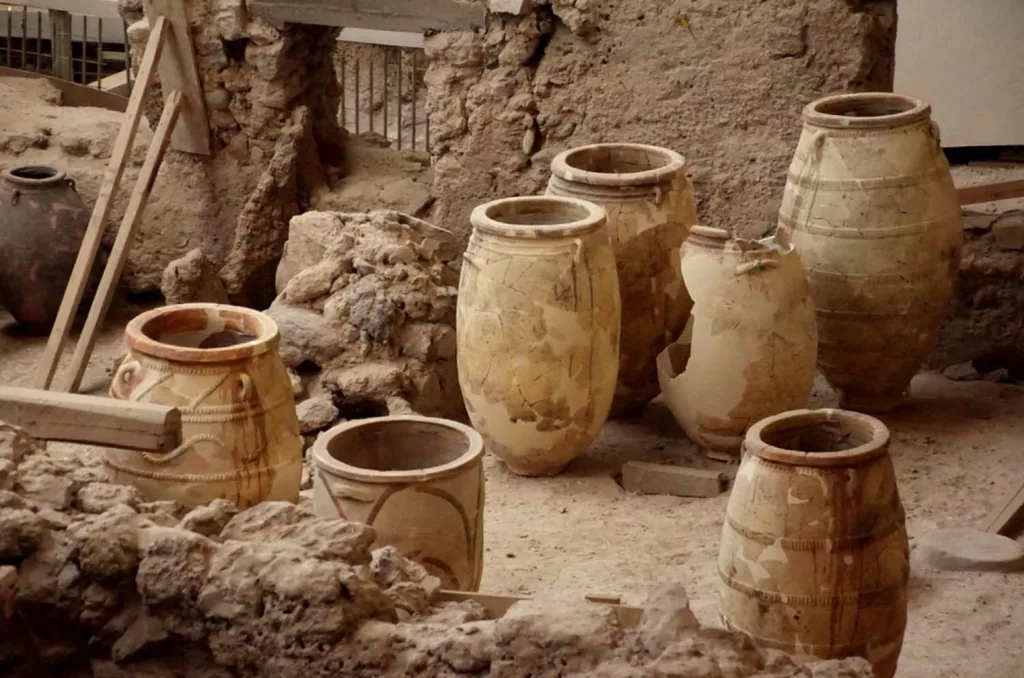
Ticket and price for the Akrotiri Archeological site
Prices for entry tickets to the Akrotiri archaeological site in Santorini are the same regardless of the time of year. Important note: If you are 25 years or younger, all museums in Greece are free for you. Take advantage!
- Normal rate: 12 euros
- Reduced rate: 6 euros
- Special 3-day rate: 15 euros (including access to various sites and museums, including the Akrotiri archaeological site, the ancient Thira archaeological site, and the Prehistoric Thera Archaeological Museum)
The Village of Akrotiri Today
The modern village of Akrotiri is just a short walk from the archaeological site. Perched on a hill with the remnants of a Venetian castle dominating the landscape. Also known as the Grand Venetian Castle of Akrotiri, this fortress, although not as well-preserved as one might imagine, is still a must-visit place during your trip to Akrotiri. It’s a peaceful spot along the coast, worth a visit after exploring the ruins.
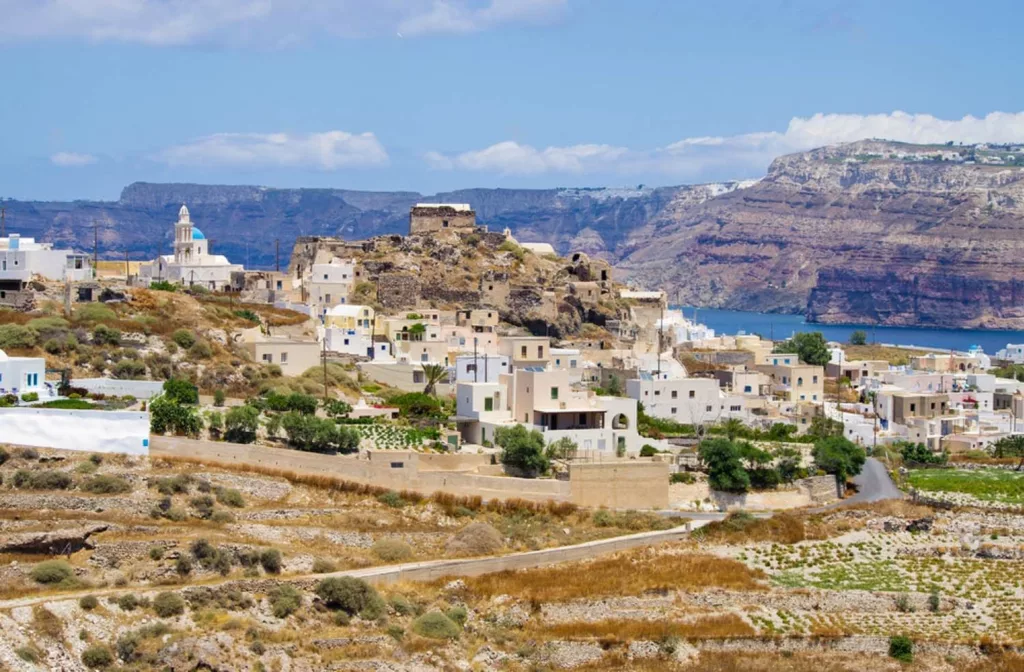
The Castle of Akrotiri in Santorini
The castle, known as La Ponta (in Venetian for “peak”), dates back to the 13th century and was built to defend the fortress during the early years of Venetian rule on the island. It consisted of a defensive tower known as Goulas and held a strategic position to protect the island, particularly against pirate raids and the most significant Mediterranean threat of the time, the Ottoman Empire.
The fortress included a small church and dozens of small houses with iron gates. The castle eventually succumbed to Ottoman rule in 1617 and remained almost intact until 1956, the year one of the most significant earthquakes on Santorini damaged most of the castle’s structure, leaving only ruins.
Music Concerts and Festivals
Each year, music festivals and concerts take place in the areas of the castle that were not damaged by the earthquake. The site now houses an important music workshop and a musical instrument exhibition. From the top of the Venetian tower, the panoramic views of the island and the coast are breathtaking. There are also guided tours during the summer, providing the opportunity to learn more about the castle’s history.
The Akrotiri Lighthouse
The Akrotiri Lighthouse is a very popular spot for tourists in Akrotiri, right after the archaeological site. It is located on the southwest tip of Santorini and offers unique views of the rugged coastline and the sea.
Dating back to 1892, the lighthouse is one of the first ever built in Greece. It was powered by oil for its first 100 years of operation, with a permanent keeper in charge of its manual operation.
The Akrotiri Lighthouse stands atop a small white house that was once the keeper’s residence. Its total height is ten meters, and it is still operational. While it is no longer manually operated, it emits a bright white beam over the sea every 10 seconds.
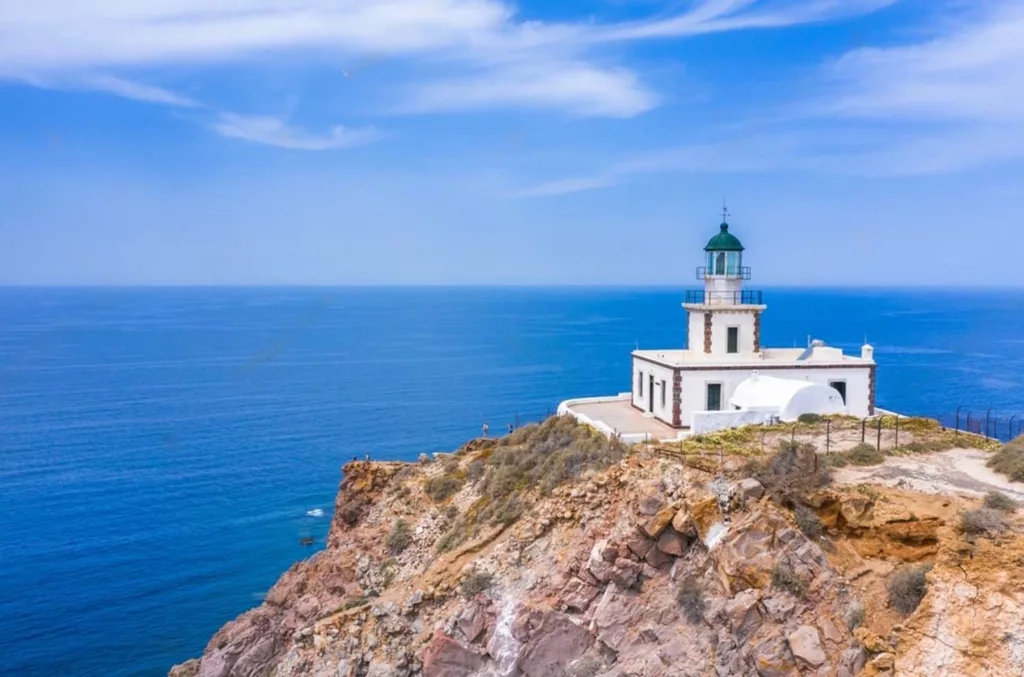
The Best Spot in Santorini for Sunsets
To visit the lighthouse, I recommend taking your quad or scooter. You can also take the bus from Fira to Akrotiri; once in the village, you can either walk or reach the lighthouse by taxi. The place is very popular in the summer, as it is, in my opinion, the best spot to watch a sunset in Santorin
The Fabulous Beaches Around Akrotiri
Red beach
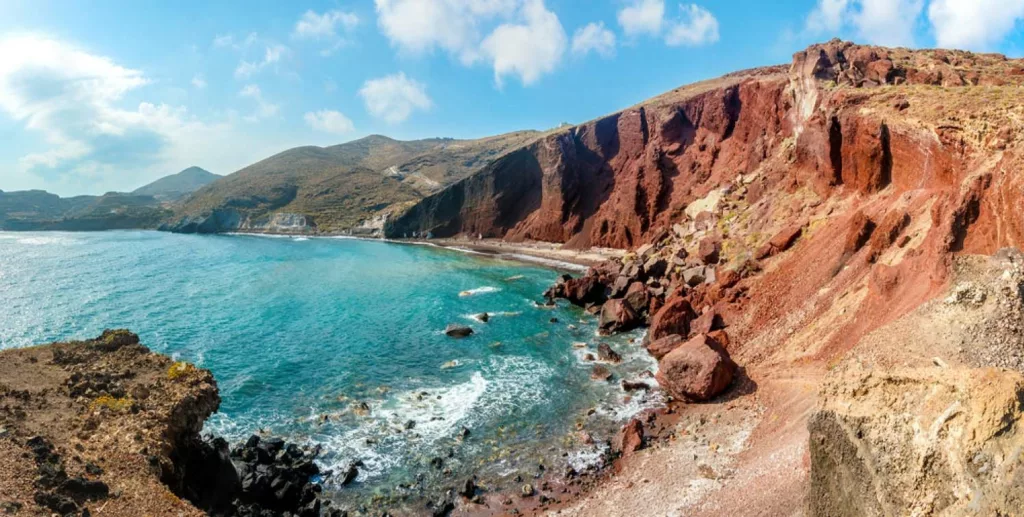
Bearing the name Kokkini Paralia, Red Beach is a must-visit in Akrotiri, Santorini. A short hike is required to access the beach, located beyond a promontory near the archaeological site.
Resulting from volcanic eruptions, this beach showcases a stunning display of dark volcanic rocks, black and red pebbles, and dark red sand. It’s a breathtaking spot to admire unique underwater rock formations and marine life.

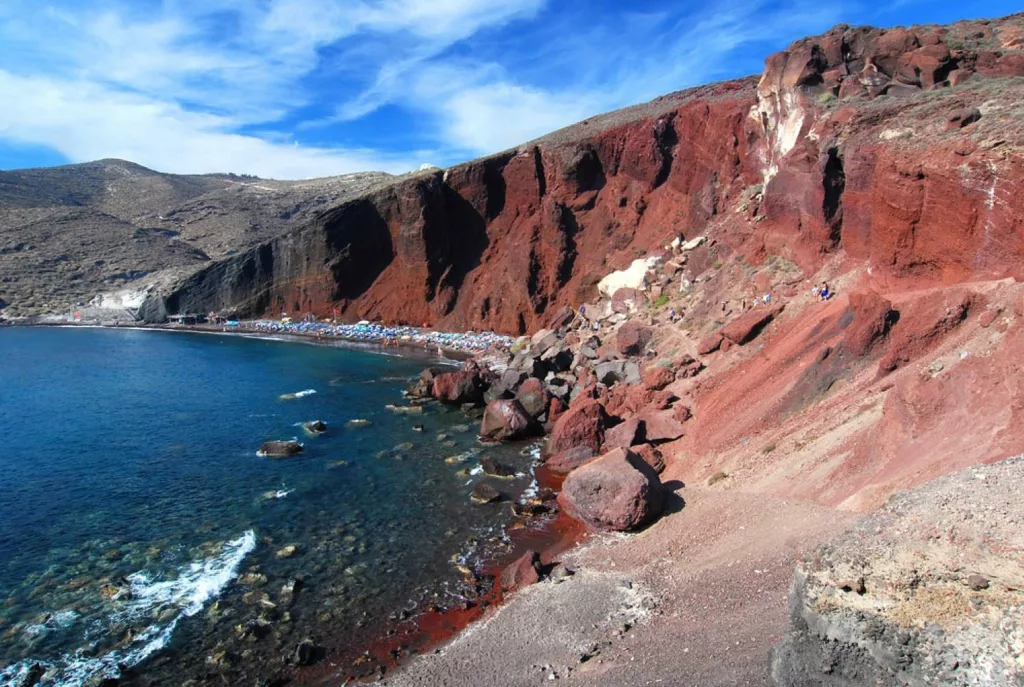
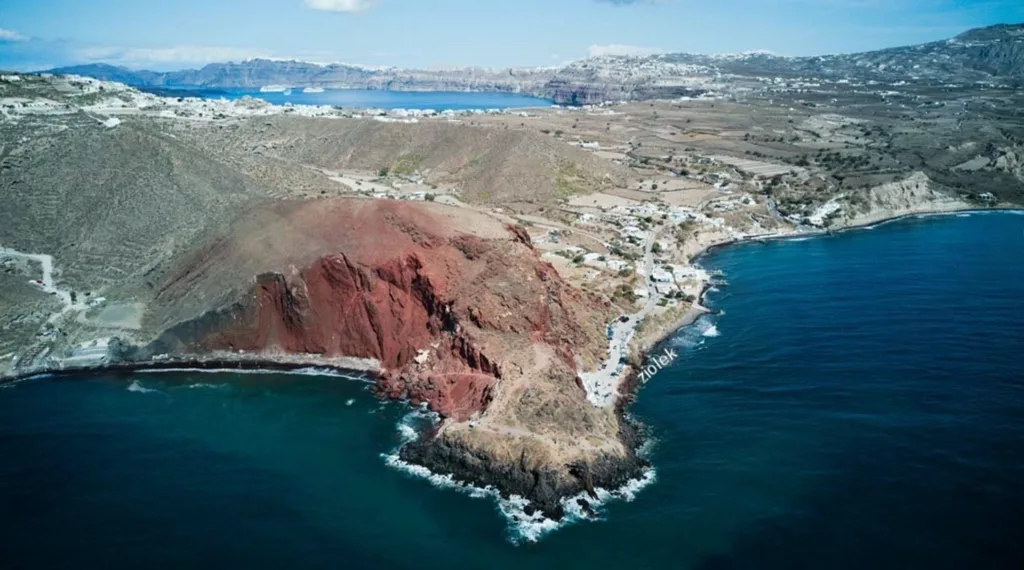

White Beach
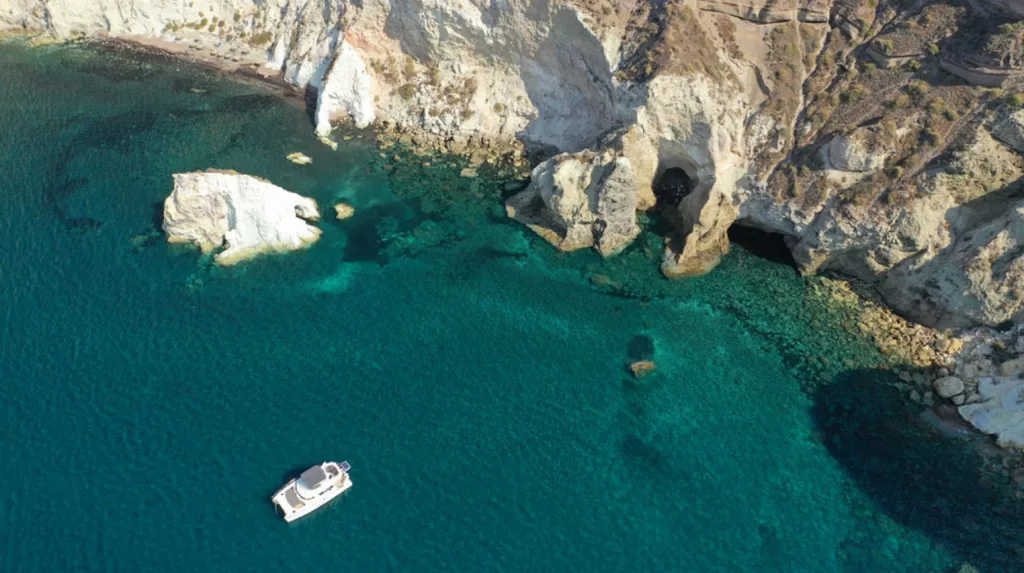
Discover the beautiful White Beach in Akrotiri, Santorini, Greece. The beach, also known as Lefki Ammos, is surrounded by imposing white cliffs and rocks, creating a picturesque and breathtaking landscape. Despite its name, the beach is covered in dark volcanic pebbles and gray sand.
Swim in the shallow emerald waters or simply relax on the sand while admiring the view of the white cliffs.
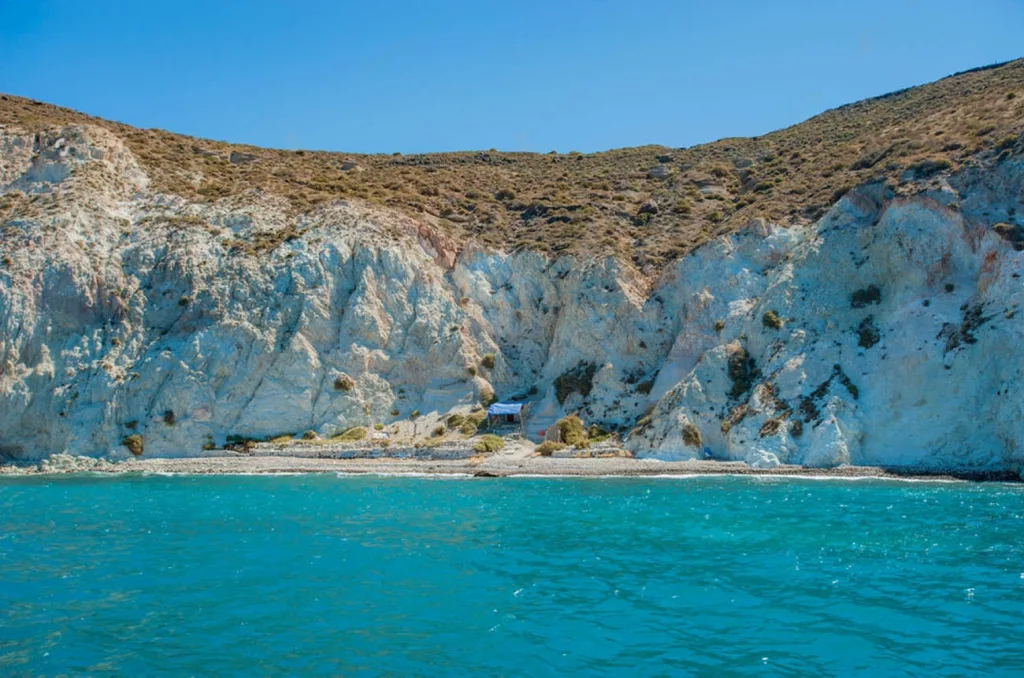
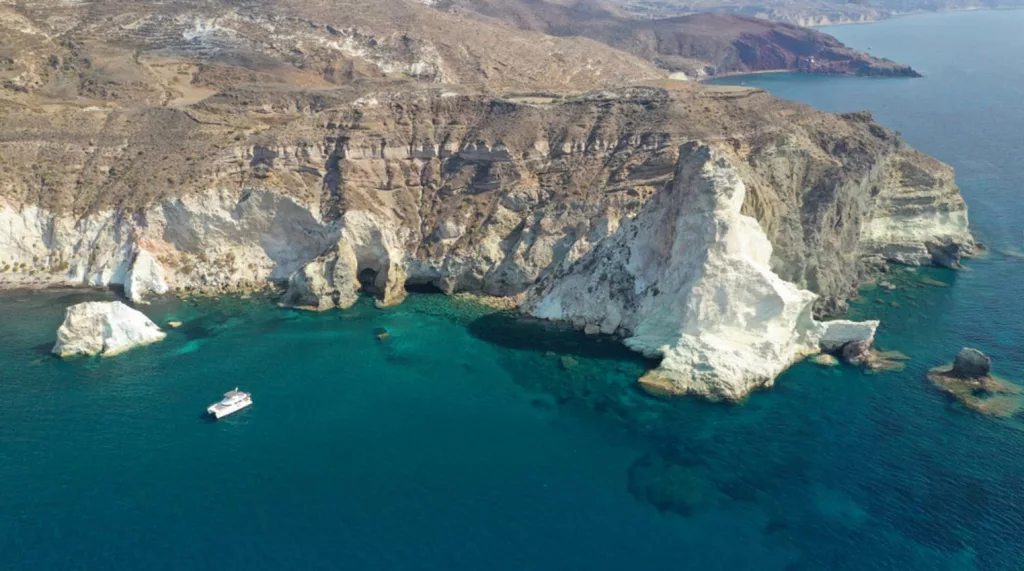
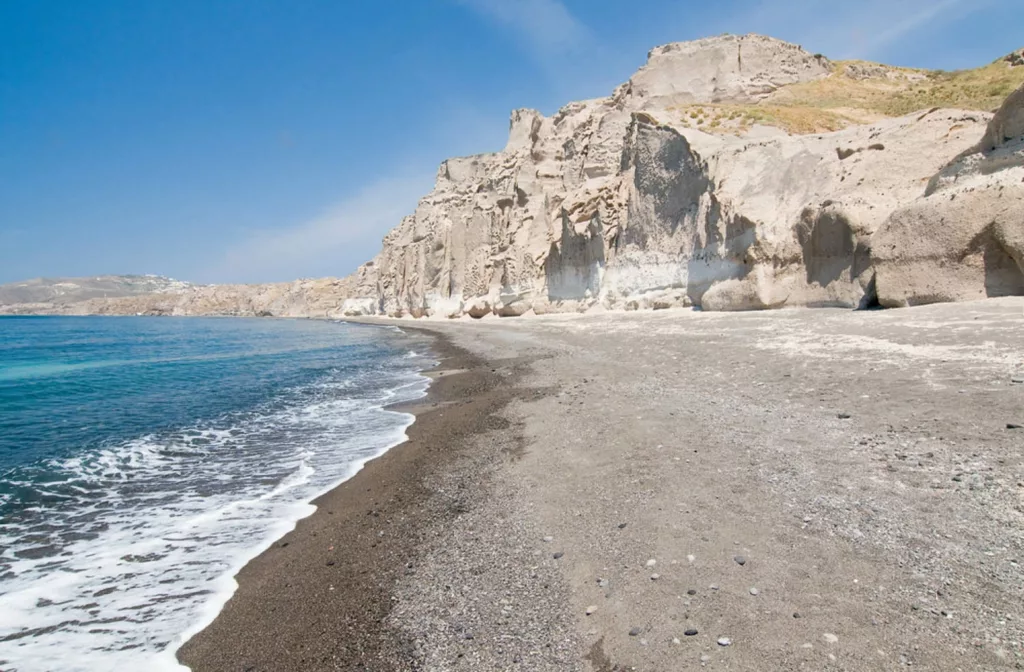
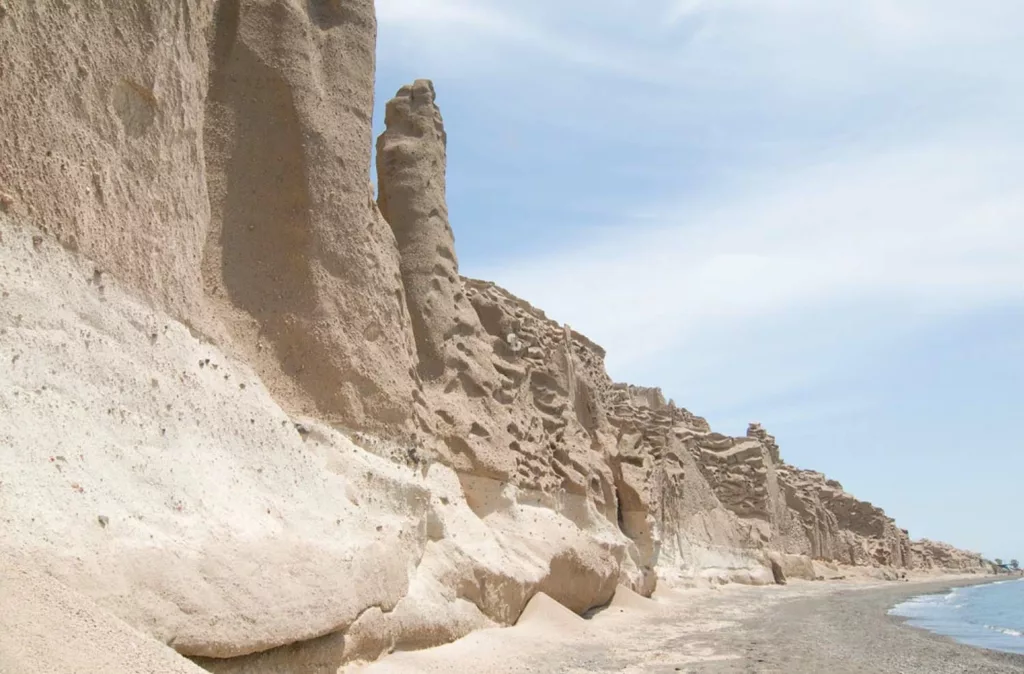
Almyra Beach
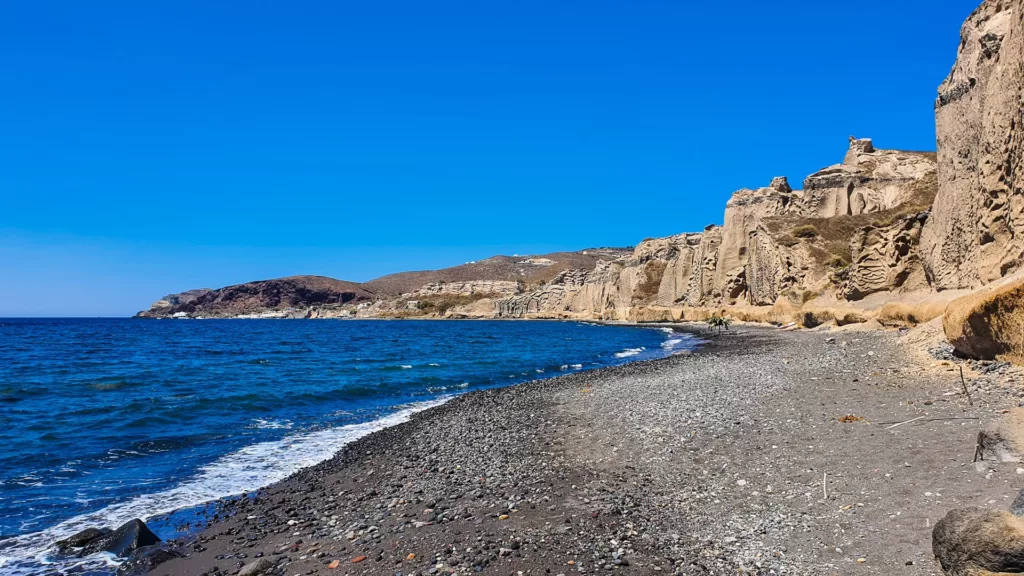
Nestled between the shores of Red Beach and Vlychada, Almyra Beach is a secluded getaway just steps from the Akrotiri archaeological site. Accessible only via a rugged path, this serene place is perfect for those seeking a more private and off-the-beaten-path experience.
Covered in smooth pebbles with crystal-clear water, Almyra is ideal for swimming and snorkeling. The imposing cliffs in the background add to the otherworldly ambiance, reminiscent of a lunar landscape.
Mesa Pigadia
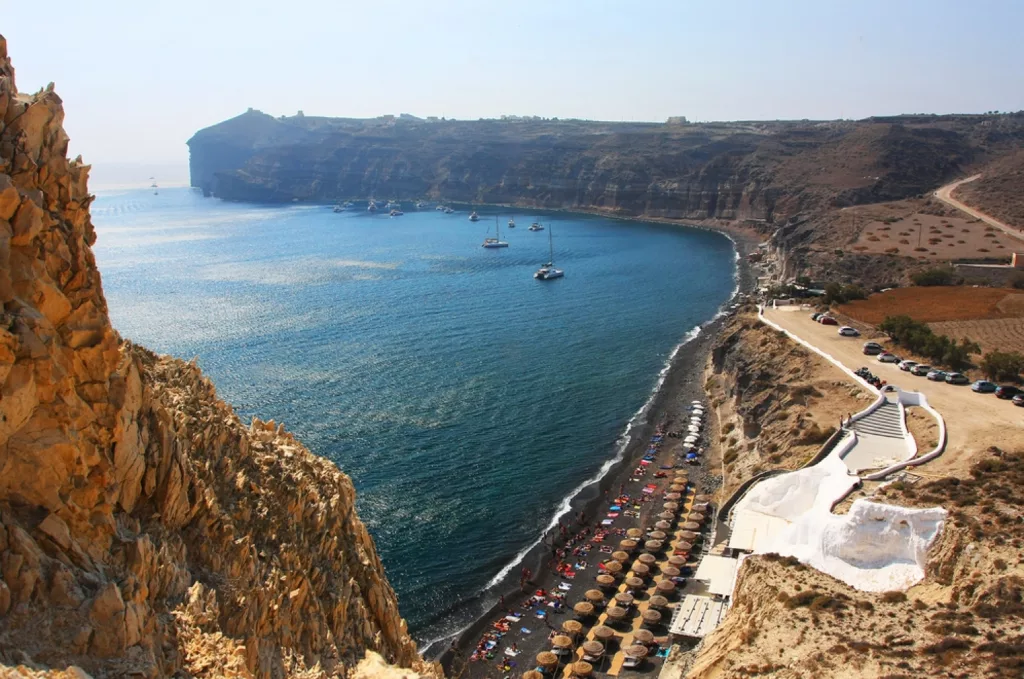
Mesa Pigadia Beach, a coastal gem near Akrotiri. Accessible by sea or land, you still need to take a short drive on an unpaved road, but it’s manageable, especially on a quad. The beach’s remote nature adds to its allure, and its proximity to the ancient Akrotiri site makes it a perfect stop on an adventure-filled day.
Stay in Akrotiri
Luxury hotels

Phos The Boutique
Located on the Caldera shores in Akrotiri, Phos the Boutique, a luxury 5-star hotel, offers breathtaking views of the Caldera. With spacious villas and suites, each featuring a private heated infinity pool with hydro-massage jets and a sun terrace with outdoor seating, this establishment provides the perfect setting for an unforgettable holiday.
Phos The Boutique
Akrotiri, Greece
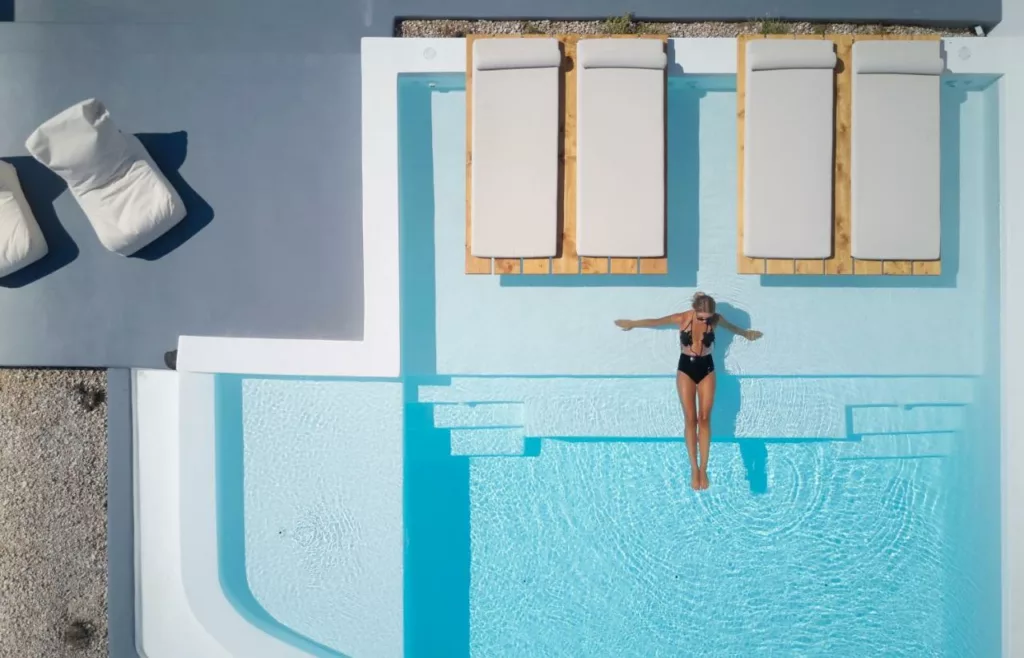

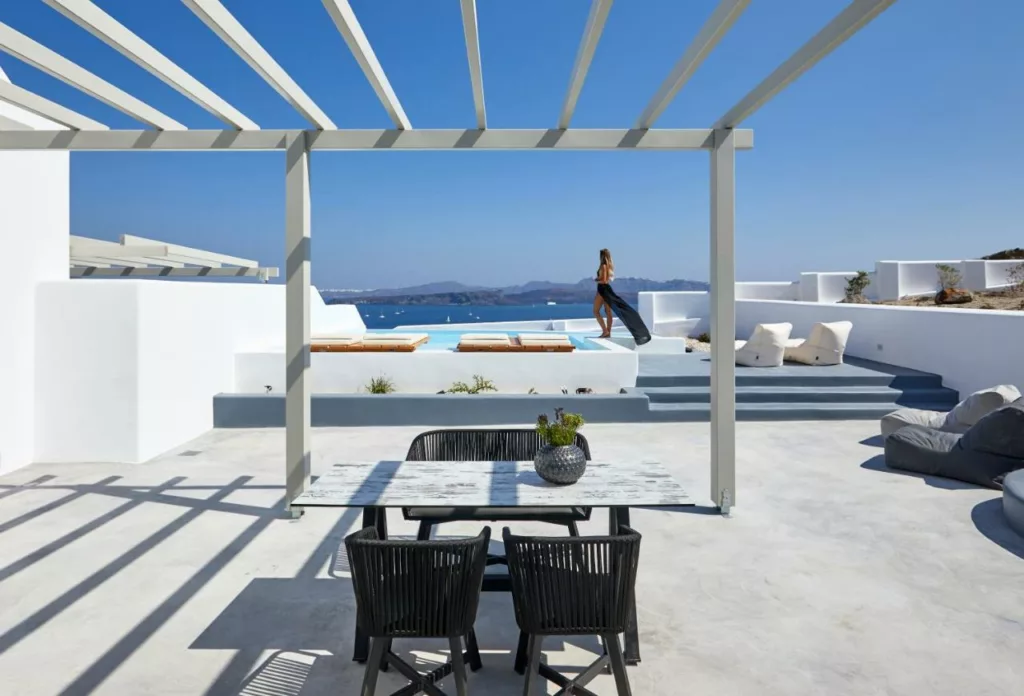
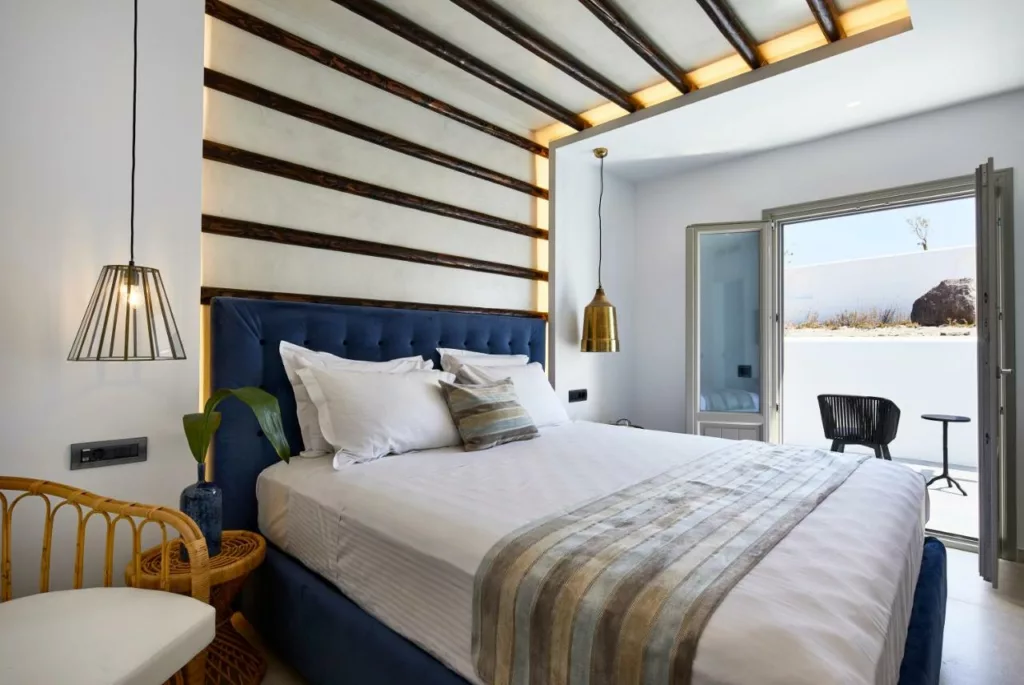
Standard hotel
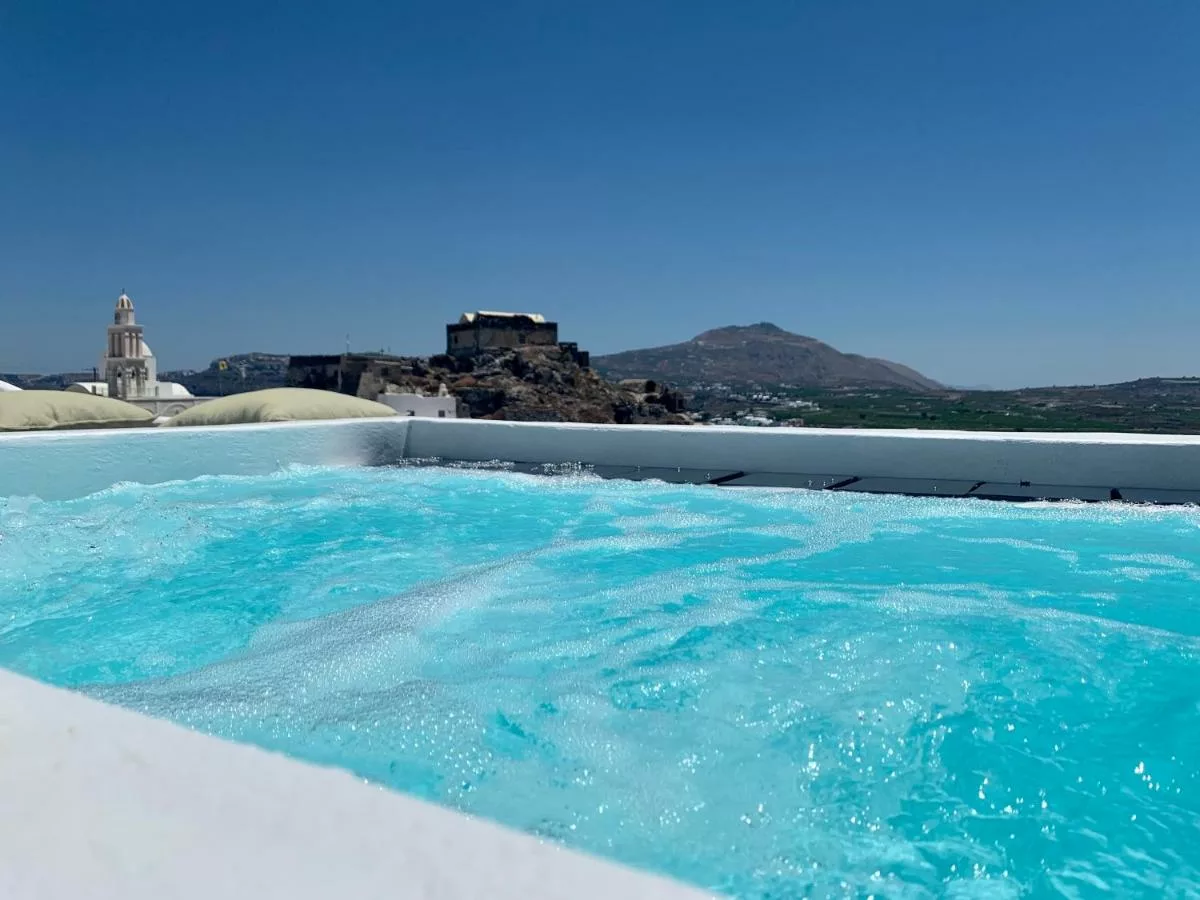
White Curve Santorini
White Curves Santorini is the perfect place for a peaceful and comfortable stay in Santorini. Located less than 1 km from the Caldera Beach, this hotel offers spacious accommodations with a private balcony.
Enjoy stunning views from your private balcony and unwind in the comfort of your lodging. White Curves Santorini is the perfect choice for travelers seeking a peaceful and comfortable stay in Santorini.
White Curve Santorini
Akrotiri, Greece
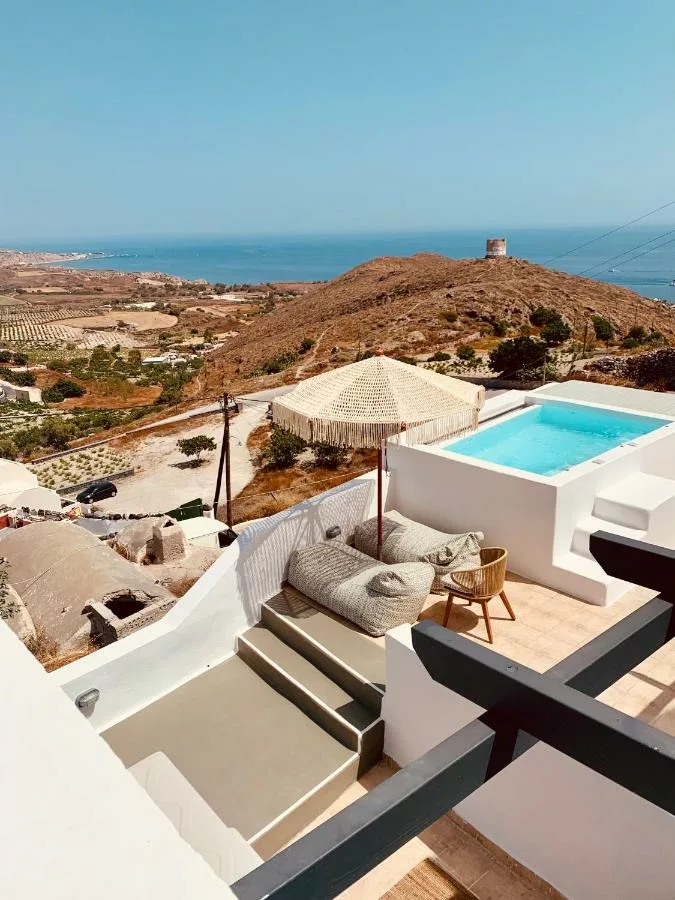
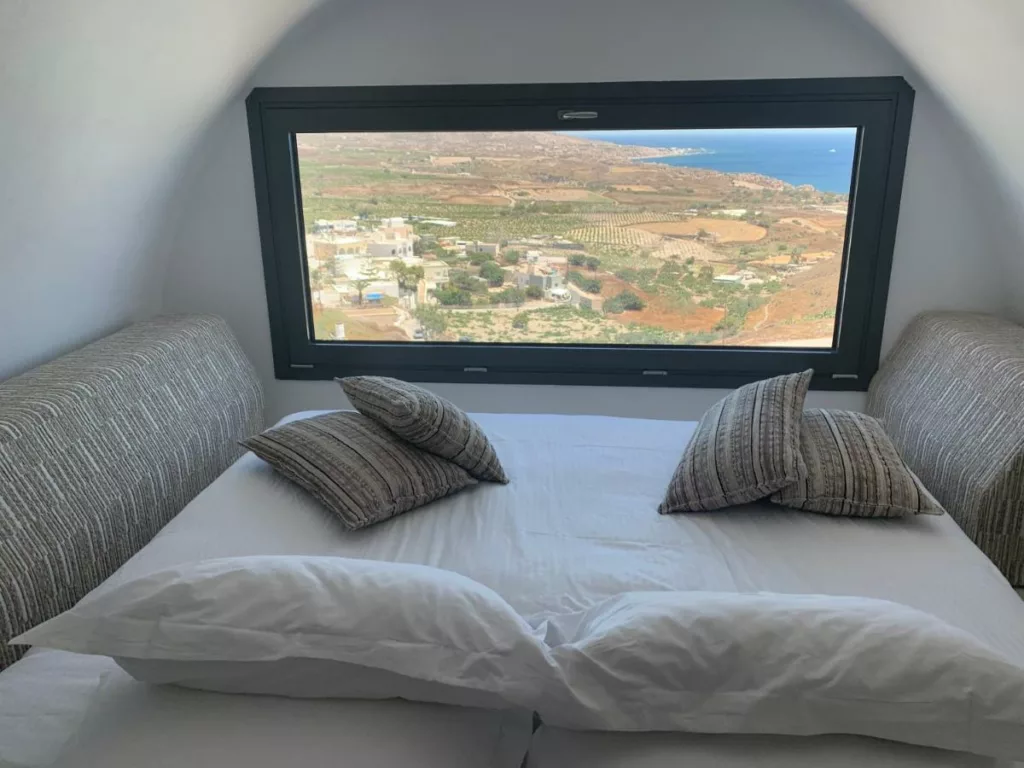
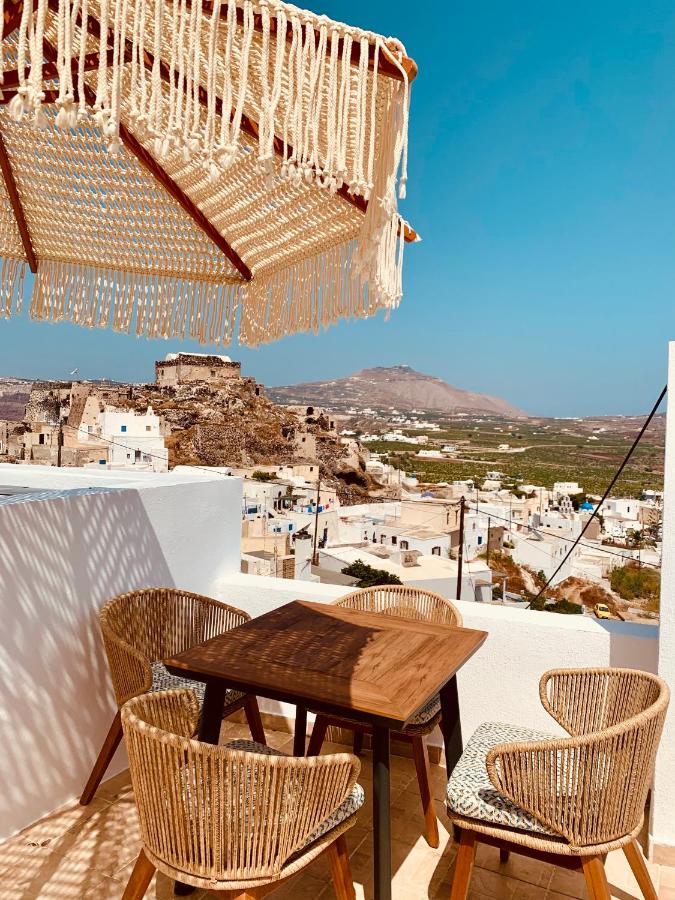
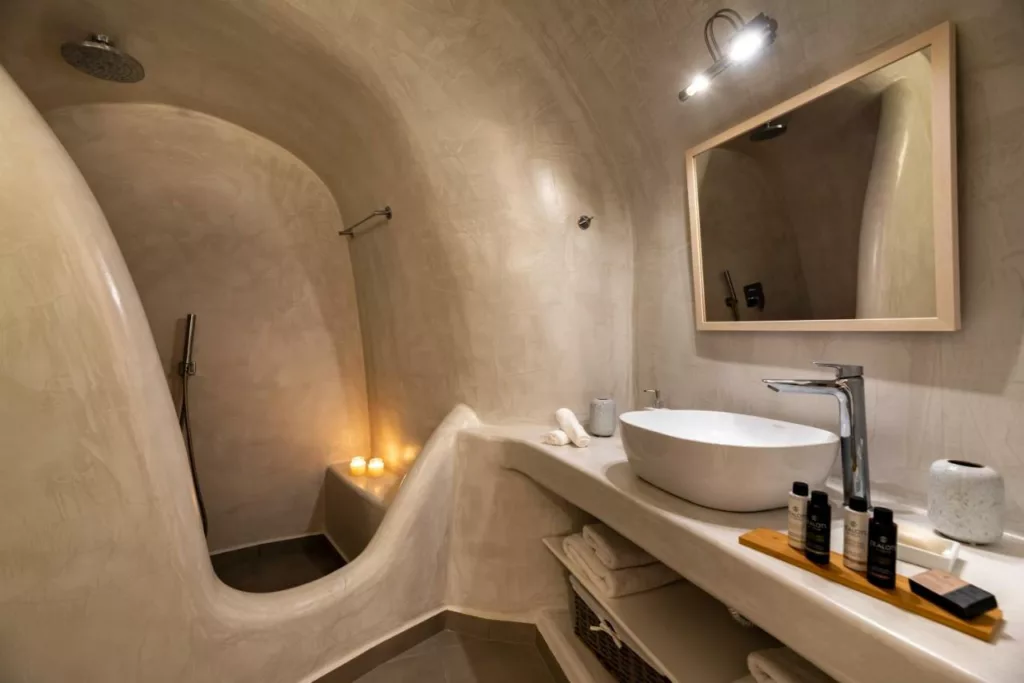
Budget hotel
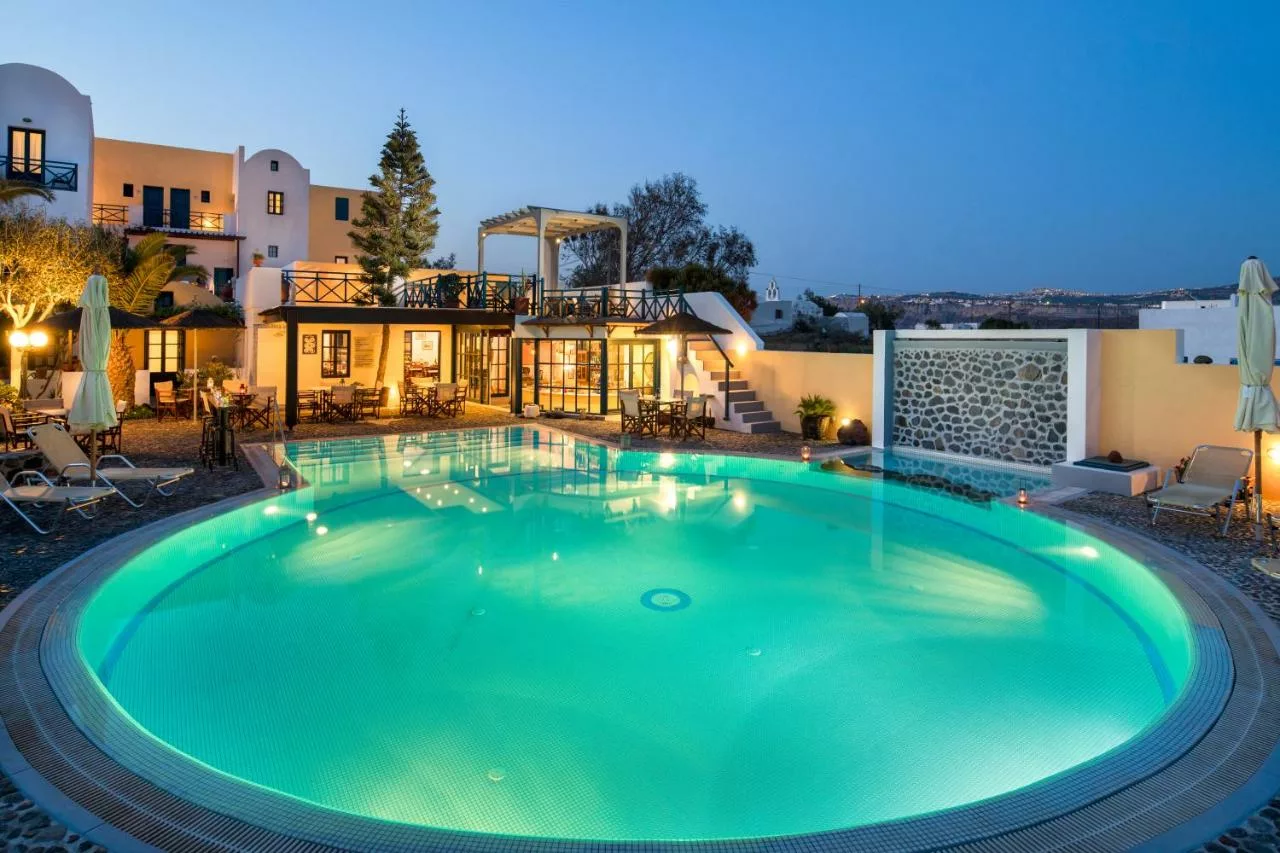
Kalimera Hotel
Kalimera Hotel is the ideal choice for those seeking a prime location for their stay in Santorini. Situated just a few meters from Red Beach and White Beach, it offers spectacular views of the caldera, the volcano, and the Aegean Sea.
The hotel, built near the Akrotiri archaeological site, offers rooms, suites, and maisonettes. All are decorated in the typical Cycladic style while providing modern comfort.
Kalimera Hotel
Akrotiri, Grèce
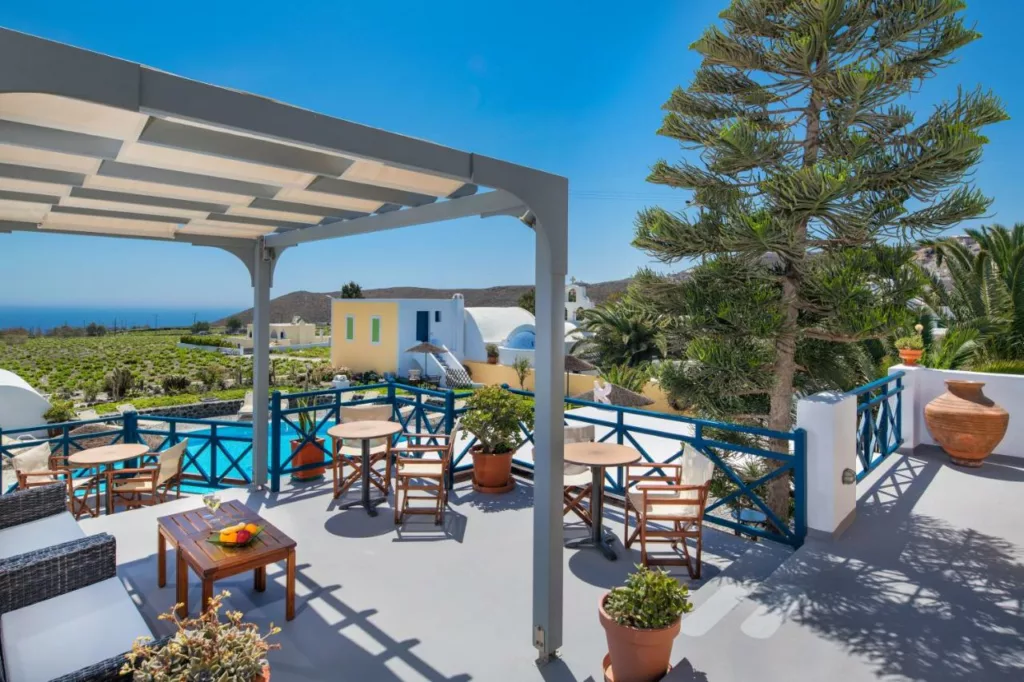
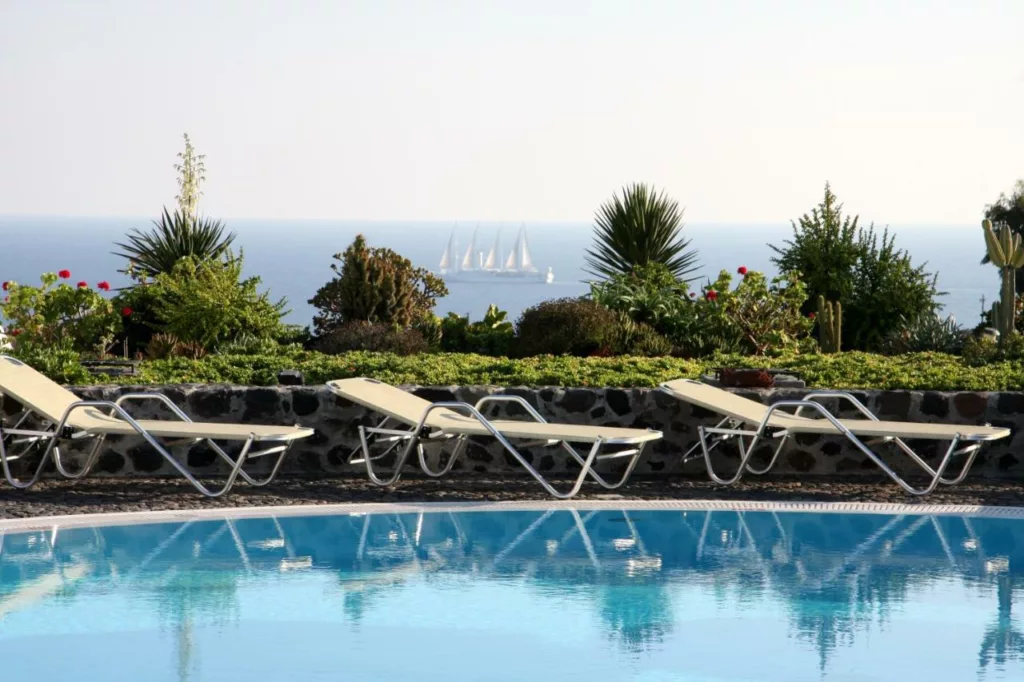
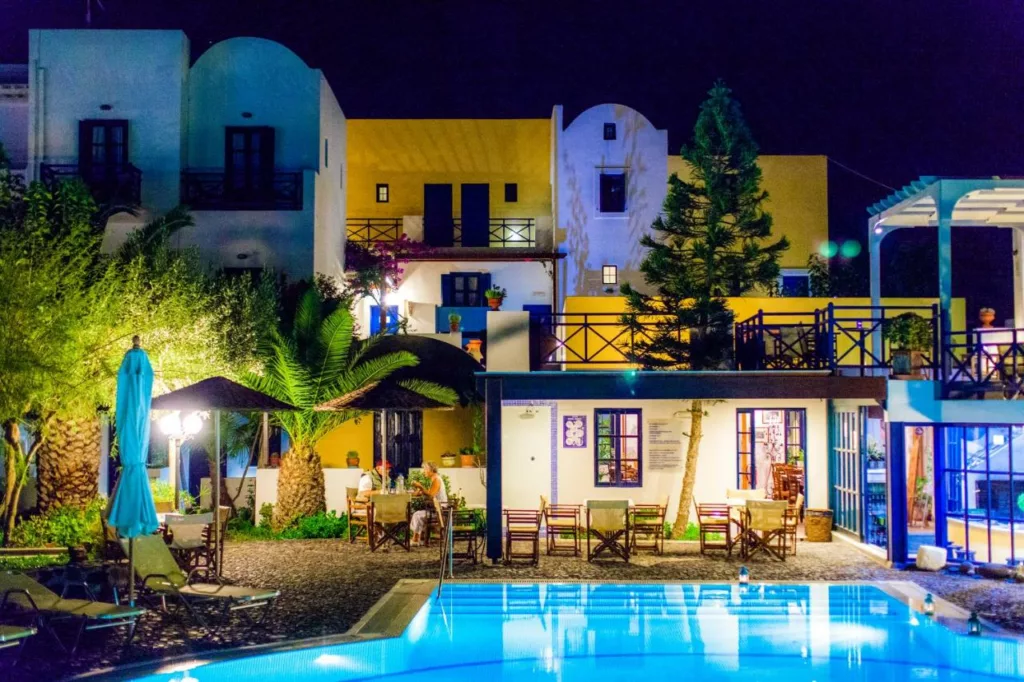
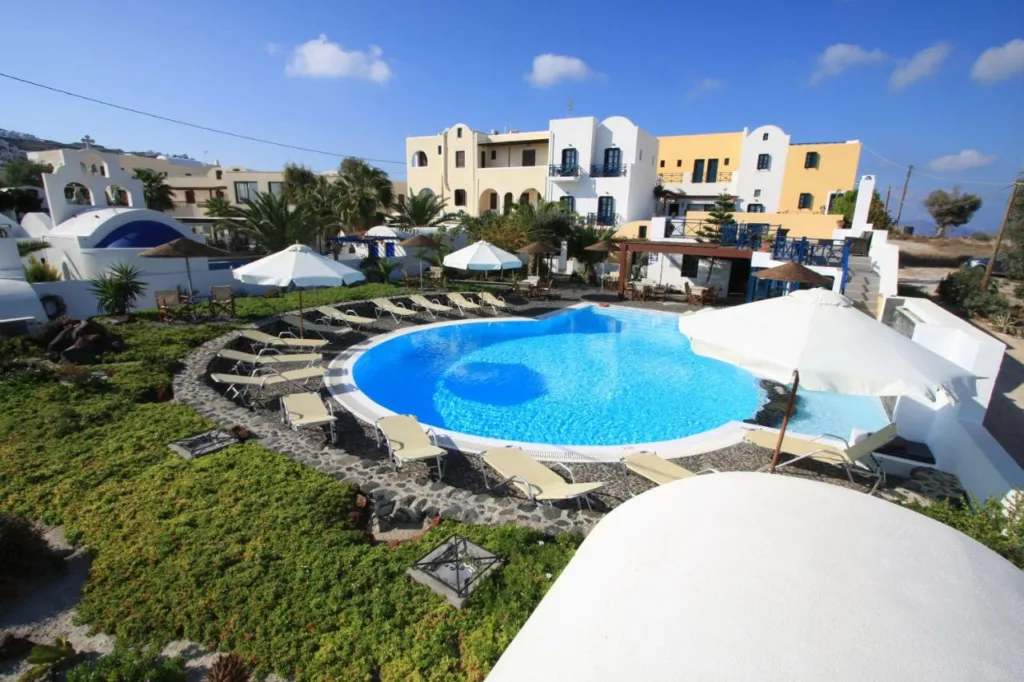
Where to Eat in Akrotiri, Santorini?
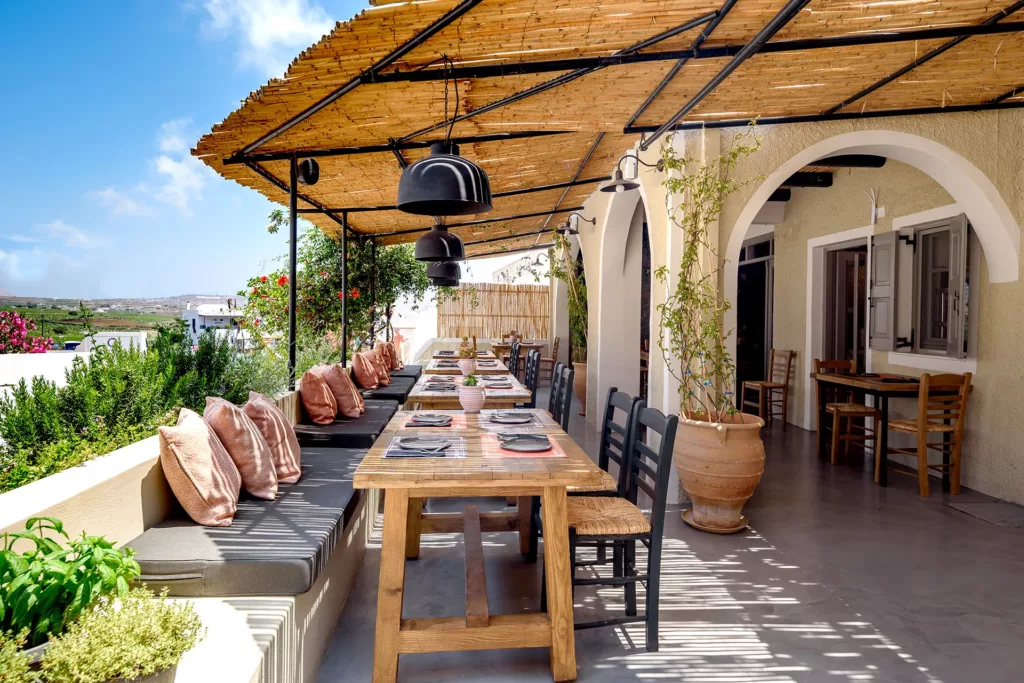
Restaurant Misteli
€€€
Misteli Restaurant is a modern take on a classic Greek tavern with roots dating back to ancient Dionysian feasts where good food and wine were essential. The restaurant draws inspiration from the colors of ancient Akrotiri and offers a menu that combines traditional Greek and Mediterranean flavors with fresh, local, and organic ingredients. From famous tomato fritters and grandmother’s favas to beloved meatballs, Misteli provides a culinary experience that will not only satisfy you but also transport you to a taste of Greece.
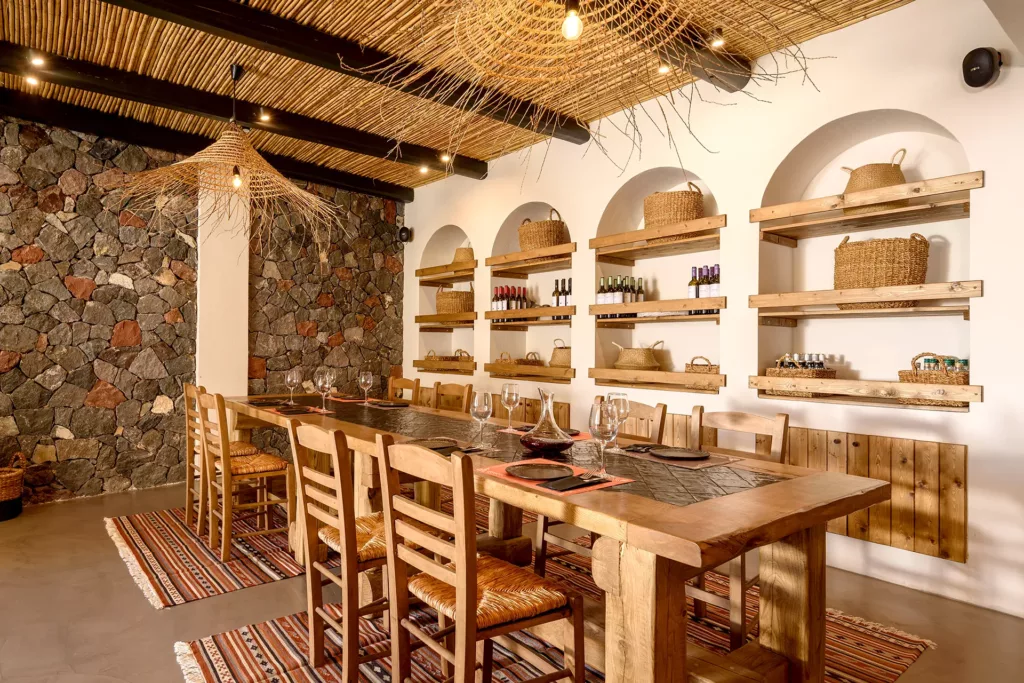
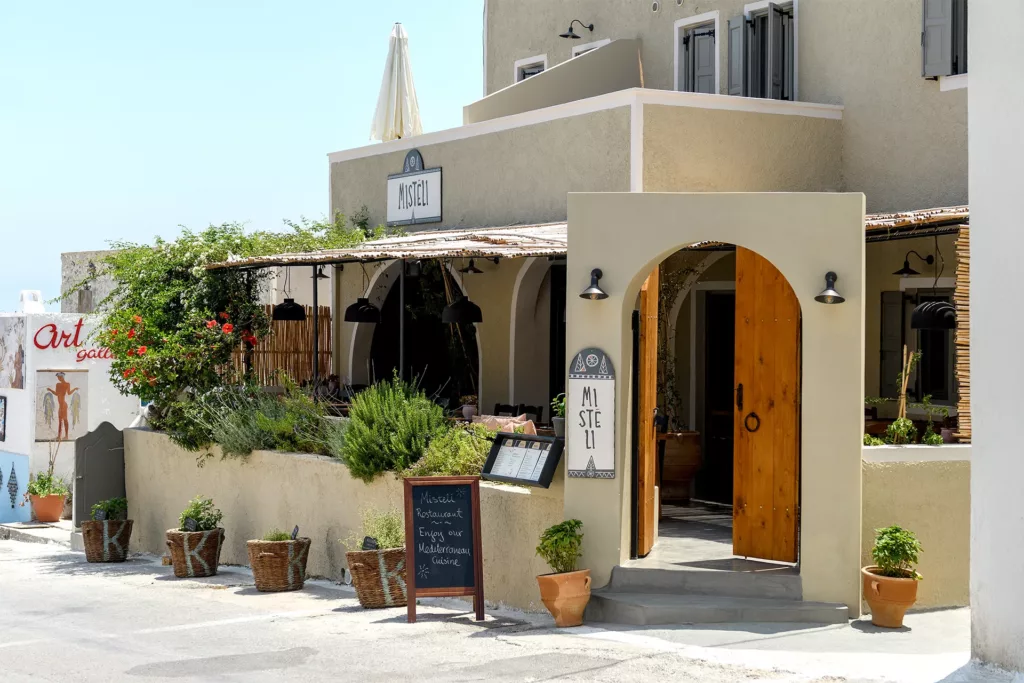

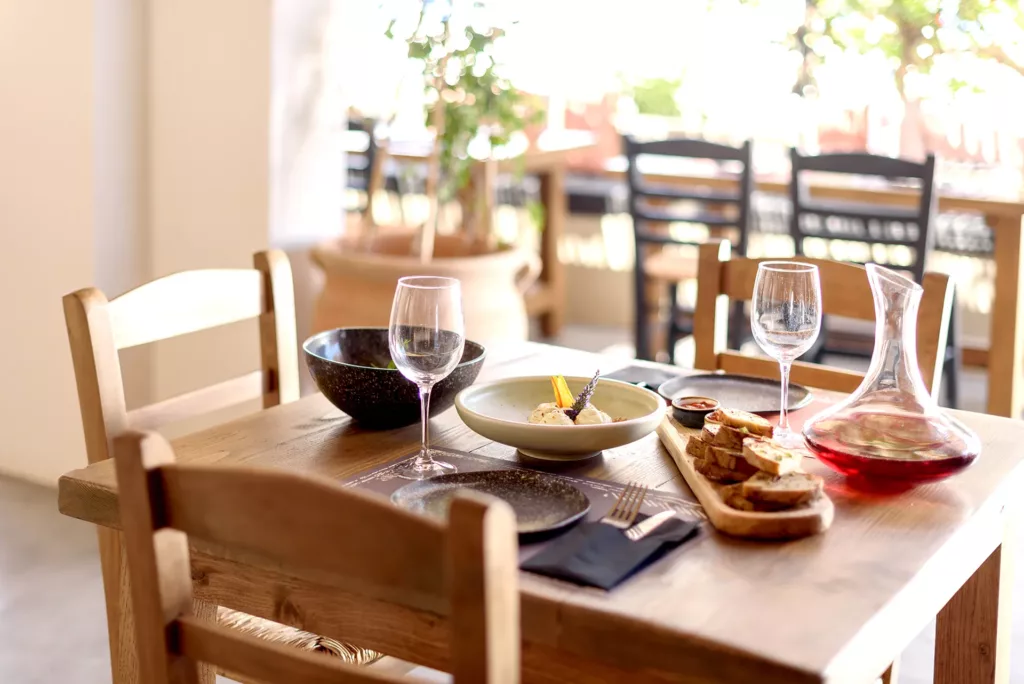
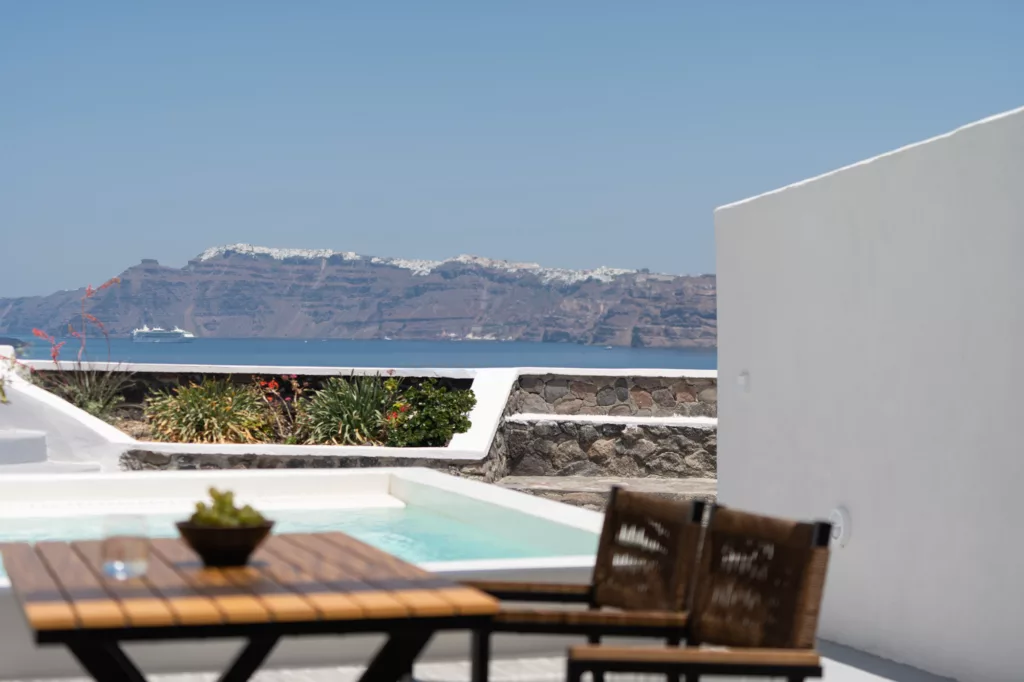
The Edge Restaurant
€€
The Edge is located on the edge of the caldera, offering panoramic views of the volcano and the Aegean Sea. It’s the perfect place to explore the flavors of Greek and Mediterranean cuisine, inspired by Santorin’s local ingredients. The menu is curated by the talented chef Katsarou Mary, who pays special attention to detail to make every dinner a sensory journey. Come and let The Edge Restaurant transform your moment into a magical culinary experience.




The map of Akrotiri in Santorini
Discover the best of Santorini
Article mis à jours le 13 October 2023 par Pierre Bouyer

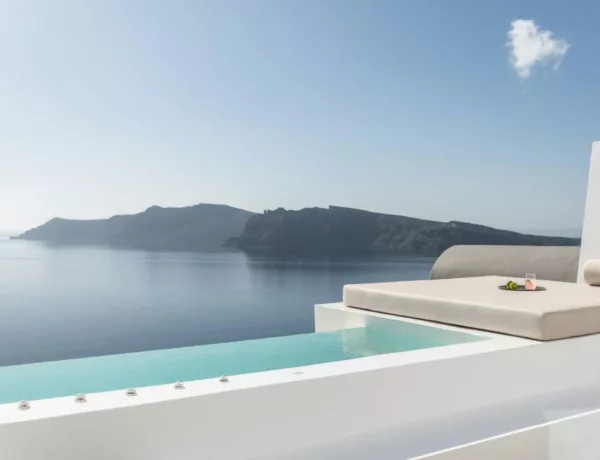


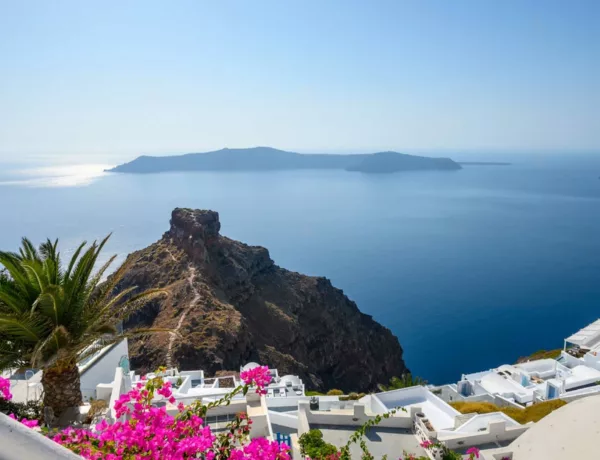

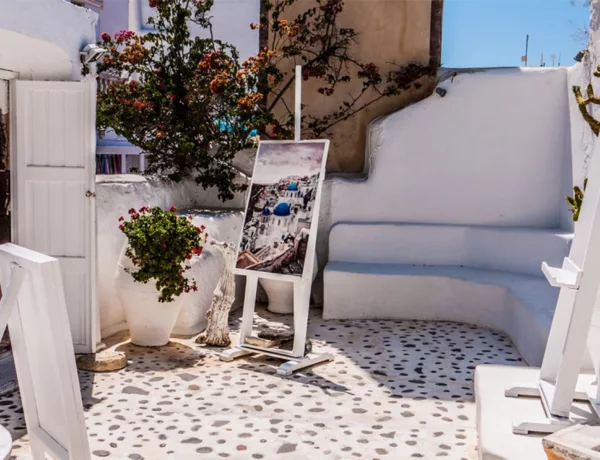


No Comments